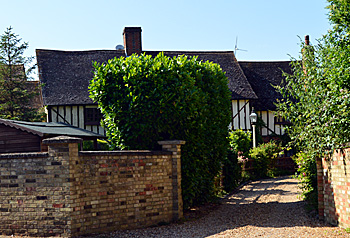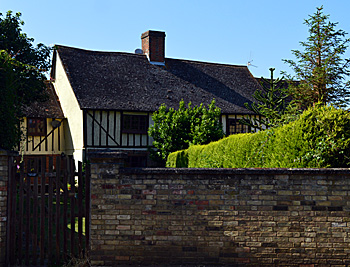6 to 10 Church Street Shillington

6 to 10 Church Street July 2015
6 to 10 Church Street were listed by English Heritage in December 1997 as Grade II, of special interest. Today they are three houses but were formerly one dwelling, dating from the 17th century and incorporating part of a medieval open hall with 19th and 20th century alterations and additions. The building is timber-framed with red brick at the ground floor level and with painted, smoothed render to the upper floor between the studwork and at the gable ends. There is a plain tiled roof. The building has a late 20th century extension to the rear.
The inclosure map for Shillington shows the property and describes it as the workhouse [MA43]. Workhouses were places where the parish sent people too poor to maintain themselves where they could stay and do useful work in return. The Poor Law Amendment Act 1834 did away with parish workhouses, replacing them with larger buildings serving a number of parishes which together formed a Poor Law Union. Thus at some point after 1834 parish workhouses began to be sold. The parish vestry withheld consent for sale in 1837 but allowed it in 1841 [P44/8/1].
A report on the parish workhouse to the Quarter Sessions from 1804 survives [QSR1804/82]. It reads as follows: "James Webster, a Justice of the Peace acting in and for the said County, having on Thursday the 29th day of December last, visited the parish workhouse of the parish if Shidlington in the said County and having examined into the State and Condition of the poor therein, do make the following report to the Court of General Quarter Sessions held his day at Bedford for the said County. That the Master of the said parish workhouse is extremely negligent in his duty, that not residing in the House, and being wholly occupied in other pursuits, he hath no time to attend to the State and Condition of the Houses or the poor therein. That the poor being under no authority are disobedient, idle and disorderly. That Quarrels, Strifes and Contentions are daily taking place therein. That much Misconduct and Irregularity prevail in the House. That Elizabeth Peck an Inhabitant of the said House is now pregnant with her second Bastard Child without any Inquiry or Concern from the Master or parish officers. That Sarah Simmons with her Bastard Child was lately turned out of said workhouse by the Master, without any just cause and is now residing with the reputed Father. It is further stated that the said parish workhouse is much neglected in regard to Cleanliness. And that some of the Coverings of the Beds, the Blankets, Sheets and Clothing of the poor are in a wretched Condition. That there are three Infants in Arms in the said House, without one Cradle being provided for their use and Benefit. That no proper Employment is provided by the Master for such poor persons as are able to work. That several of these, and especially the females, are absent from the House whole nights and days together, contrary to decency and good order that the overseers of the poor of the said parish are peculiarly negligent in their duty, that they seldom visit the House, or inquire into the State and Condition of the poor therein. These Representations are humbly submitted to the considerations of the Court of General Quarter Sessions, which court will be pleased to make such order therein as to them shall seem meet".
This led to the Quarter Sessions issuing an order to the parish to appoint a new master and to remedy the defects [QSR1804/1]. The order specifies: "That the windows and tiling of the said House be repaired and that the inside of the House be whitewashed throughout as soon as the Season will permit".
In 1829 ashes and dung from the workhouse were to be sold and John Chavel and his wife were appointed Master and Mistress [P44/8/1]. The Chavels lasted one year being replaced by John Munns in 1830 [P44/8/1]. The workhouse had an orchard and the assistant overseer was given use of this in 1831 [P44/8/1]. The master changed again in 1832 – this time it was Thomas Cherry [P44/8/1]. Two years later he was instructed to shave the male inmates and "to apply his whole time in parish business" [P44/8/1.
The Rating and Valuation Act 1925 specified that every building and piece of land in the country was to be assessed to determine its rateable value. At that time all three houses were owned by Samuel D Simkins and Sons, corn merchants. Number 6 [DV1/C75/60] was occupied by Mrs S Jepps who paid £5 per annum for a living room and one bedroom. Number 8 [DV1/C75/59] was in occupation of G Rust and Number 10 [DV1/C75/58] by C Hinge, who both paid six guineas per annum (a rent set in 1925) for a living room, a kitchen and two bedrooms. A barn stood outside. The block was described by the valuer as "Neglected, old and rambling".

Numbers 6 to 10 Church Street July 2015